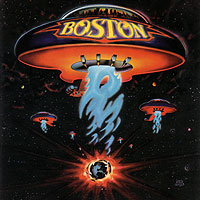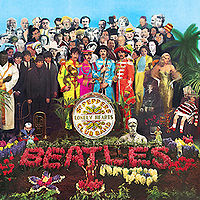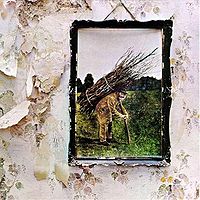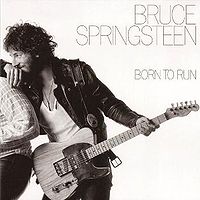 Driving to the grocery store yesterday, I heard Smokin’ by Boston on the radio. Which got me thinking — how many rock albums can you name in which every single song on the album gets regular radio airplay?
Driving to the grocery store yesterday, I heard Smokin’ by Boston on the radio. Which got me thinking — how many rock albums can you name in which every single song on the album gets regular radio airplay?
I can only come up with two, and they are both arguably not legitimate. The first, of course, is Boston’s first album, Boston. It is unquestionable that, of the eights songs on the record, six of them (More than a Feeling, Piece of Mind, Foreplay/Longtime, Rock n’ Roll Band, Hitch a Ride, and Let Me Take You Home Tonight) get regular radio airplay. The other two songs (Something About You and Smokin’) might not qualify for “regular” airplay, but you definitely hear them once in a while.
The other record I came up with is Led Zeppelin IV. Again, six of the songs (Black Dog, Rock n’ Roll, Stairway to Heaven, Misty Mountain Hop, Going to California, and When the Levee Breaks) are no-brainers. The other two (The Battle of Evermore and Four Sticks) probably only qualify if you define the question as “ever get any airplay” rather than “regular airplay.”
I couldn’t come up much of anything else that was even close. I guess Sgt. Pepper comes the closest, in that 11 of its 12 substantive tracks (not counting the reprise) get at least occasional airplay. But I’ve never heard Within You, Without You on the radio. Not once. This does point to one advantage that Boston and Led Zep IV have — both of them only have eight songs. And Zeppelin was well known for making short records and not worrying about stuffing them will filler to achieve a certain song count or time length. (Consider that Physical Graffitti is a double album that only runs 15 songs and 80 minutes).
 But let me turn to the main matter of this post: sequencing a rock record. It dawned on me when I was thinking about this question over the weekend that the three records mentioned above are all, in my opinion, examples of extraordinarily well-sequenced records. That is, to say, the ordering of the songs on the album is well-chosen and adds to the experience of listening to the record. Both Boston and LZIV have wonderful first-song choices; More than a Feeling’s opening fade-in guitar and first lyric of I woke up this morning is exactly the mood setter that record needs. Black Dog, almost to the point of obviousness, would have been completely out of place anywhere but first position (save perhaps at the top of side 2, but even that’s a stretch); it’s almost tough to give Zep credit for that sequencing choice, there’s probably not a better example of a song that needed to go in a particular spot on an album.
But let me turn to the main matter of this post: sequencing a rock record. It dawned on me when I was thinking about this question over the weekend that the three records mentioned above are all, in my opinion, examples of extraordinarily well-sequenced records. That is, to say, the ordering of the songs on the album is well-chosen and adds to the experience of listening to the record. Both Boston and LZIV have wonderful first-song choices; More than a Feeling’s opening fade-in guitar and first lyric of I woke up this morning is exactly the mood setter that record needs. Black Dog, almost to the point of obviousness, would have been completely out of place anywhere but first position (save perhaps at the top of side 2, but even that’s a stretch); it’s almost tough to give Zep credit for that sequencing choice, there’s probably not a better example of a song that needed to go in a particular spot on an album.
Sgt. Pepper is rather brilliant in this regard — it fits together almost perfectly. I have always especially loved the contrast from the final few seconds of When I’m Sixty-Four and the opening measures of Lovely Rita. Of course, as I understand it, the Beatles struggled for weeks to sequence the album, unable to fit it together correctly until a young studio engineer who had not previously been part of the discussion happened upon a haggard Lennon, McCartney, Harrison, and George Martin talking about it, spinning their wheels. He took one look at the tentative track listing and said, “You need to record a reprise to Sergeant Pepper’s Lonely Hearts Club Band, put it next to last, and then fade it into A Day in the Life.” Everyone in the room kinda stood silent for a minute, until Lennon looked at the kid and said, “No one likes a wiseass. Now get the hell out of here.”
 I don’t think there’s anything more than a weak correlation between how well a record is sequenced and how popular it stays 30 years later, but I do think that there’s a marginal effect. And it certainly true that poor sequencing can hurt an albums’ sales if the band is relatively unknown and the key nodes (A&R men listening to demos, DJs listening to 1st releases) turn the music off before they reach the best songs. Some of the greatest albums of all time are very well sequenced (in addition to those above, Nirvana’s Nevermind is a clear winner) and others are quite poor (Pearl Jam’s Ten is bad, in my opinion; The Clash’s London Calling is unforgivable).
I don’t think there’s anything more than a weak correlation between how well a record is sequenced and how popular it stays 30 years later, but I do think that there’s a marginal effect. And it certainly true that poor sequencing can hurt an albums’ sales if the band is relatively unknown and the key nodes (A&R men listening to demos, DJs listening to 1st releases) turn the music off before they reach the best songs. Some of the greatest albums of all time are very well sequenced (in addition to those above, Nirvana’s Nevermind is a clear winner) and others are quite poor (Pearl Jam’s Ten is bad, in my opinion; The Clash’s London Calling is unforgivable).
The single best album that I believe has huge sequencing mistakes is Born to Run. Such a glorious album, and yet so butchered by its sequencing. Here’s the track listing of the album: Thunder Road, Tenth Avenue Freeze Out, Night, Backstreets, Born to Run, She’s the One, Meeting Across the River, and Jungleland. (Born to Run is the first song on side two). There are at least a few major sequencing mistakes here. The first — and most obvious — is that Thunder Road should not have been the first song on the album. The right choice was clearly Night. The latter, both musically and lyrically, captures the exact mood one wants to open a record with: excitement and possibility, an invitation to leave your regular life behind and join the party. For god sake’s, read the lyrics: As you lock up the house, turn out the lights, and step out into the Night!…and the world is bursting at its seams, and you’re just a prisoner of your dreams!…and you’re in love with all the wonder it brings, and every muscle in your body sings!
Thunder Road has a completely different vibe. It certainly has a mood of possibility and future, but it’s tinged with regret, sadness, and hopelessness. Especially given the way the song closes, it should have been the last song on the record, not the first. My guess is that someone at the record company wanted Thunder Road first and not Night. I say this because in 1976, Springsteen was opening his concerts with Night (for example, see this setlist from Colgate University, 4/9/1976. Again, an obvious choice and a clear indication that the Boss probably saw the song the same way that I describe it above.)
This is not to say that Thunder Road should definitively have been the last song on the record. I think it’s fairly safe to say that the two sweeping epics on the album — Thunder Road and Jungeland — needed to go at the end of side one and side two. Amd I can see arguments for Jungleland being the last song. But they fall fast if you listen to the last 45 seconds of each of the songs. Thunder Road fades out with a memorable piano/sax line, repeated over and over. Jungleland could end brilliantly for a last song if they had cut it close to the final lyric (“…tonight in Jung…gle…Land.”), but instead it trails into a wishy-washy musical section with the boss doing some tonal overlays (probably the worst part of the record; definitely detracts from the overall appeal of Jungleland). As is, I would put Jungleland at the end of side one, Thunder Road at the end of side two. This, of course, does pose one problem: what to do with Backstreets, another good end-0f-a-side type of song that currently sits at the end of side one?
I think the answer is fairly obvious once you get Night into proper position: put Backstreets second. The whole point of having Tenth Avenue Freeze Out second, I think, was the musical contrast from Thunder Road. But that’s solved by opening with an up-tempo rocker like Night, and so all of a sudden Backstreets — with it’s subtle piano riff opening — falls naturally in place. Of course, they knew this; Backstreets follows Night in the original sequencing!
The last major change, I think, is to get Born to Run onto the front of the album. There’s definitely something delcious about starting off side two with it, but that’s not really the mood of side two. So I’d put Born to Run after Backstreets, and then put Tenth Avenue Freeze Out first on side two. So here’s my final sequencing for Born to Run: Night, Backstreets, Born to Run, Jungleland, Tenth Avenue Freeze Out, She’s the One, Meeting Across the River, Thunder Road. I think that’s vastly superior to the existing sequence. But don’t take my word for it — go play it in your Ipod in that order (either maunally or by changing the track numbers in Itunes to fool your Ipod; I recommend the latter) and see for yourself.
Of course, in the age of the Ipod it’s not obvious that anyone under the age of 25 even listens to records straight through, or that musicians or record compaines even consciously think about sequencing as much as they did 40 years ago. Certain dynamics have definitely changed: there’s no record/tape to flip anymore, so the idea that the last song on side one and the first song on side two should mean anything is gone. And the effort needed to change tracks has virtually disappeared since the wide adoption of the CD. Chuck Klosterman likes to joke that the 2008 Guns n’ Roses album Chinese Democracy is the last true “album,” because it took them 15 years to make it and thus it was begun before the age of the Ipod, when an album was still a tighter collection of music. Which, I suppose, makes me something of a nostalgist here.


Pingback: Born to Sequence | Matt Glassman
Pingback: ON SUBMITTING MP3s FOR THAT JOB OPENING YOU’RE PURSUING « Mike O'Malley's Blog